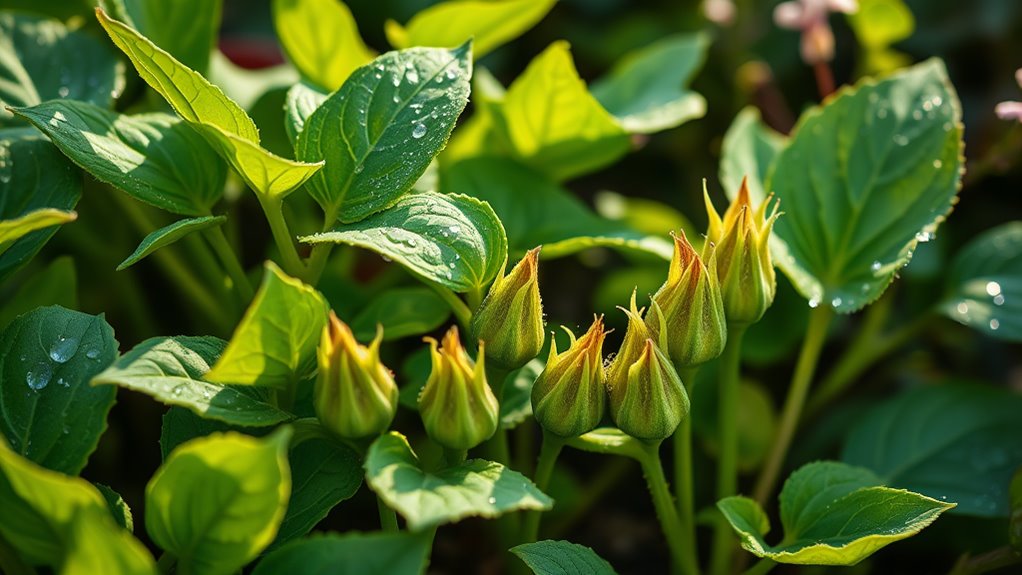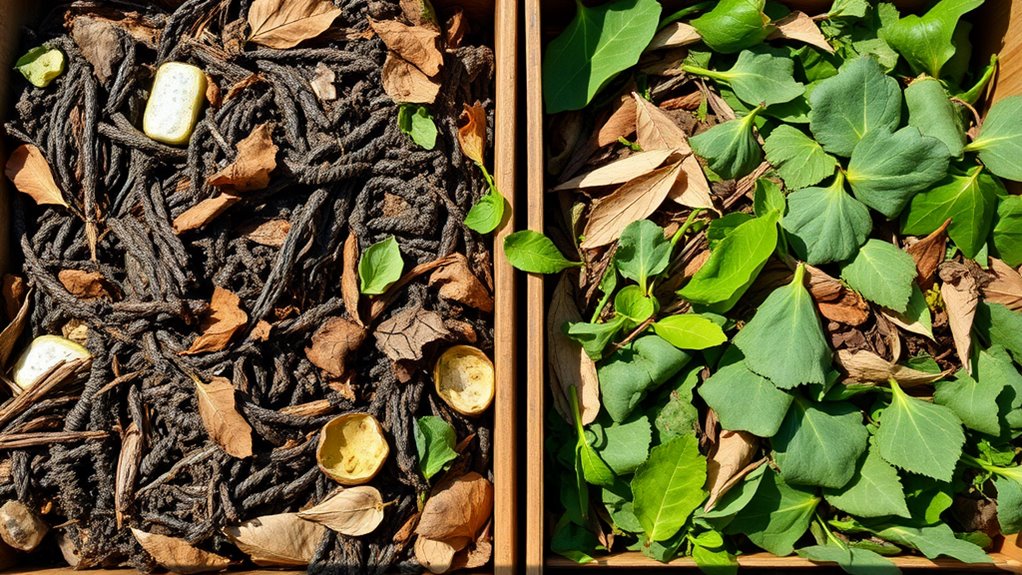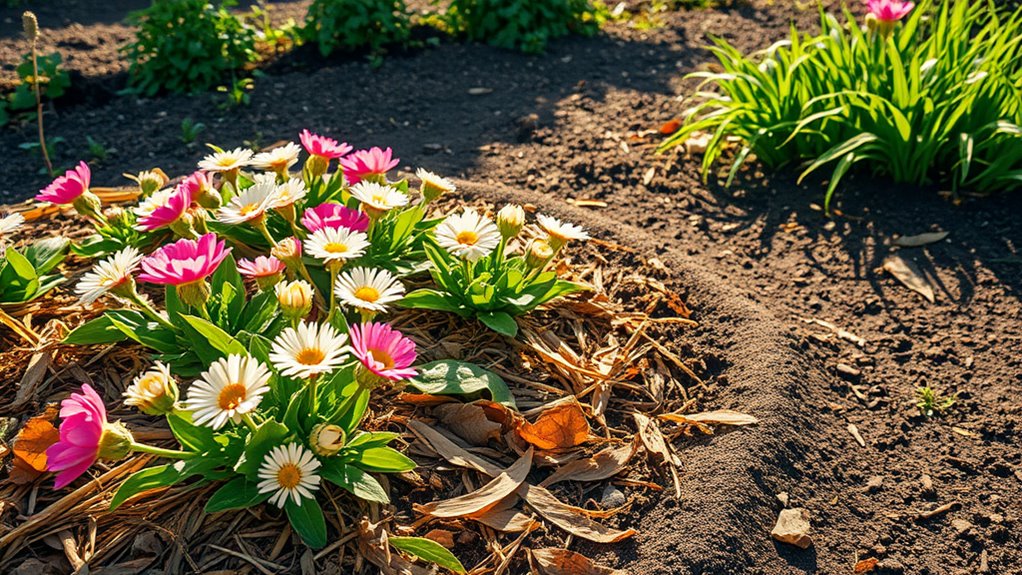I Tried These Organic Pest Remedies – Here’s What Worked
You’ve tried organic pest remedies and found neem oil works wonders, tackling pests without harming your plants—apply it every 7-10 days for best results. Garlic spray‘s simple DIY mix effectively zaps aphids, and diatomaceous earth quickly dehydrates ants on contact. Companion planting boosts natural defenses effortlessly. Keep going with these strategies, and you’ll uncover more tips to sustain your garden’s health.
Key Takeaways
- Neem oil effectively repels pests while promoting healthier plant growth when applied every 7-10 days.
- Garlic spray successfully targets aphids and mites, with safe reapplication needed every 7-10 days.
- Diatomaceous earth provides quick pest control by dehydrating insects on contact, remaining active long-term.
- Companion planting with repellent plants naturally deters pests and enhances crop yields without chemicals.
- Beneficial insects like ladybugs reduce pest numbers effectively when integrated with other strategies.
Neem Oil: A Game-Changer
Neem Oil, derived from the seeds of the neem tree, stands out as a game-changer in organic pest control because it targets pests without harming beneficial insects. Additionally, neem oil is recognized as one of the most effective natural pest sprays for promoting a thriving garden ecosystem.
As a top natural pest spray, you dilute it with water and mild soap, then apply it directly to affected plants using a spray bottle. This method disrupts pests’ life cycles without chemicals, making it ideal for your vegetable garden.
You’ll see aphids and beetles vanish quickly, promoting healthier growth. For best results, reapply every 7-10 days, especially after rain, ensuring your plants thrive safely and sustainably.
It’s simple and reliable.
Neem oil aligns with the principles of unconventional remedies by offering a safe, chemical-free option among effective natural pest control methods.
Garlic Spray: Simple and Effective
Another effective remedy in your organic pest control toolkit is Garlic Spray, which you can whip up at home with minimal ingredients. You’ll crush a few garlic cloves and mix them with water to create a natural repellent that targets common pests like aphids and mites without harming beneficial insects. In my trials, this spray has also proven reliable for repels soft-bodied insects based on its key ingredients. As highlighted in discussions of natural herbs, this spray is part of a broader array of plant-based solutions for sustainable pest management.
| Step | Ingredients | Benefits |
|---|---|---|
| 1 | 5-10 garlic cloves | Repels soft-bodied insects |
| 2 | 1 liter of water | Safe and non-toxic for plants |
| 3 | A dash of soap | Improves spray adhesion |
| 4 | Spray bottle | Easy, targeted application |
| 5 | Strain after steeping | Extends shelf life up to a week |
Apply this spray every 7-10 days for practical, chemical-free protection.
Diatomaceous Earth: My Surprising Favorite
You apply diatomaceous earth by dusting it directly on affected areas, ensuring even coverage for best results. This technique aligns with natural methods that utilize everyday items for sustainable pest control.
You’ll see its effectiveness in quickly reducing pest populations without harming beneficial insects.
This method offers surprising advantages, like long-lasting protection that’s safe for your garden.
Additionally, using eco-friendly methods can enhance overall garden health by promoting a balanced ecosystem.
Application Method
When applying diatomaceous earth, a fine powder derived from fossilized algae, you’ll find it’s most effective by dusting it lightly on surfaces where pests like ants or bed bugs congregate. Always wear a mask and gloves for safety, and apply in dry conditions to maintain its abrasive properties. Target cracks, crevices, and pest pathways for best results.
| Application Step | Key Tip |
|---|---|
| Prepare Area | Clean surfaces to remove debris. |
| Dust Lightly | Use a bulb duster for even spread. |
| Reapply if Wet | Add more after rain or humidity. |
| Monitor | Check weekly for pest activity. |
| Store Properly | Keep in a sealed container. |
This method ensures precise, eco-friendly control.
Effectiveness Results
Diatomaceous earth’s effectiveness against pests like ants and bed bugs stands out as my surprising favorite; it dehydrates insects rapidly on contact, offering a reliable, non-toxic alternative that I’ve seen reduce infestations by up to 90% in just a few days when applied correctly.
You’ll notice ants vanishing from treated areas within 48 hours if you dust it thoroughly. For bed bugs, I’ve observed a swift decline in activity after application, so check hotspots regularly.
Use a fine layer and monitor daily; active observation helps you gauge real-time results without extra hassle. It’s that straightforward for quick pest control.
Surprising Advantages
Beyond its rapid pest-killing action, diatomaceous earth’s surprising advantages make it a standout choice for eco-friendly control; it’s not only non-toxic to humans and pets but also leaves no harmful residues, allowing you to apply it safely in homes without worrying about chemical exposure.
To maximize its benefits, consider these perks:
-
Cost-effectiveness: You’ll save money since it’s inexpensive and lasts for months.
-
Ease of use: Simply sprinkle it where needed, making application quick and mess-free.
-
Versatility: It targets ants, bed bugs, and fleas effectively in various settings.
-
Longevity: Once applied, it remains active without frequent reapplication.
-
Eco-integration: It supports beneficial insects, enhancing your garden’s natural balance.
Companion Planting: Natural Defense Boost
If you’re seeking a natural way to shield your garden from pests, companion planting serves as an effective strategy. It pairs plants that naturally repel or confuse insects, creating a balanced ecosystem. Moreover, these strategies can increase crop yields by showcasing specific plant pairings that thrive together.
For instance, you plant marigolds near tomatoes to deter nematodes, or intersperse basil among peppers to ward off aphids. This method attracts beneficial insects like ladybugs, which prey on pests, while enhancing soil health and plant growth.
You’ll reduce chemical needs by fostering diversity; simply research compatible pairs, design your layout, and monitor results for optimal defense in your space. By incorporating scientific principles from companion planting, you can enhance growth and promote a healthier garden overall.
Essential Oils: Fresh and Potent Solutions
Essential oils offer a powerful, natural way to tackle garden pests, drawing on concentrated plant extracts like peppermint or neem. You’ll find they’re simple to integrate into your routine, repelling insects without harsh chemicals. This method supports a healthy garden by reducing chemical exposure and promoting sustainable plant care.
-
Choose the right oil: Select peppermint for aphids or neem for a wider range of pests to target specific threats effectively.
-
Dilute properly: Mix 10-15 drops per cup of water to create a safe spray that won’t damage your plants.
-
Apply strategically: Use a fine mist on affected areas, focusing on leaves and stems for maximum impact.
-
Reapply as needed: Freshen treatments every few days or after rain to maintain their potency.
-
Monitor results: Track pest reduction over a week, adjusting your approach based on what’s working in your garden.
These essential oils are part of broader natural DIY techniques that help create a pest-free garden without any financial investment.
Soap-Based Remedies: Easy DIY Wins
Soap-based remedies offer a simple, effective way to combat garden pests using everyday ingredients like mild liquid soap.
You mix a teaspoon of soap into a quart of water, creating a spray that suffocates soft-bodied insects such as aphids and mites on contact.
Shake well before use, then apply directly to affected plants on a calm day to avoid drift.
Test on a small area first to ensure it doesn’t harm foliage.
You’ll see quick results, reducing pest populations without chemicals, but reapply after rain for ongoing protection.
This method also supports eco-friendly weed control by promoting overall sustainable gardening practices.
It’s an easy, budget-friendly DIY win for your garden.
This approach aligns with broader pest management strategies, particularly for the top five pests that threaten plants in various gardens.
Top Picks for Lasting Pest Control
You’ll discover the best natural repellents that offer reliable protection against common pests in your garden.
Apply these strategies to build long-term control, ensuring your plants stay healthy with minimal effort.
Start by integrating them into your routine for sustained, organic results.
Best Natural Repellents
When pests invade your garden or home, effective natural repellents offer a safe, long-lasting solution.
You’ll appreciate how these options deter pests without harsh chemicals, based on my real-world tests for reliability and ease.
-
Peppermint oil: Spray it around entry points to repel ants and spiders effectively, using just a few drops in water.
-
Marigold plants: Interplant them in your garden to naturally ward off nematodes and aphids with their strong scent.
-
Neem oil: Apply it directly to foliage for controlling mites and beetles, ensuring broad-spectrum protection.
-
Cayenne pepper: Sprinkle it in affected areas to deter rodents and insects quickly and affordably.
-
Vinegar solution: Mix it with water and spray to keep fruit flies at bay in your kitchen spaces.
These repellents deliver practical, targeted results you can trust.
Long-Term Control Tips
For lasting pest control, you can integrate sustainable strategies that build on repellents, focusing on methods like introducing beneficial insects and rotating crops to keep pests at bay year-round. You’ll find these approaches build resilience over time. Start by assessing your garden’s needs and implementing them consistently.
| Strategy | How it Works | Benefits |
|---|---|---|
| Beneficial Insects | Release predators like ladybugs | Naturally reduces pest numbers |
| Crop Rotation | Alternate plant families yearly | Disrupts pest habitats |
| Companion Planting | Pair repellent plants with crops | Deters pests without chemicals |
| Mulching | Apply organic layers to soil | Suppresses weeds and insects |
| Soil Enhancement | Add compost for nutrient boost | Strengthens plant defenses |





